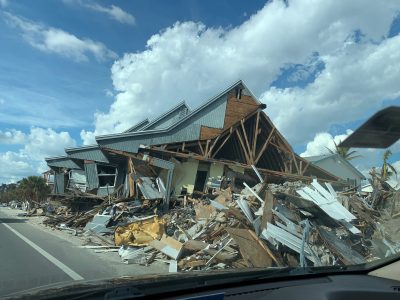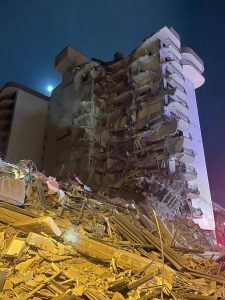Plus, disaster housing
Much of the immediate need in disaster recovery is in providing human services, especially housing. That was a focus this past week in a legislative committee examining hurricane response and resilience, following Hurricanes Ian and Nicole. Plus, some new questions and considerations in Florida’s condominium and high-rise building re-inspection law. It’s all in this week’s Disaster Management Digest.

A series of homes destroyed on Ft. Myers Beach during Hurricane Ian, November 6, 2022. Courtesy, Kevin Miller
Disaster Housing: The House Select Committee on Hurricane Resiliency & Recovery heard a presentation last week from the Florida Housing Finance Corporation (FHFC) about Hurricane Assistance Programs in Florida. Much of the presentation centered on the resources available to local governments for hurricane recovery in the housing sector. Each local government’s Local Housing Assistance Plan (LHAP), in order to receive funding through the State Housing Initiatives Partnership Program (SHIP) is required to include a strategy to address housing needs during and after declared disasters. The state puts $5 million in reserve each fiscal year for such use. These funds are allocated to eligible local governments affected by disasters based on damage data provided by FEMA and other sources. Additionally, the Hurricane Housing Recovery Program (HHRP), established by the Legislature in 2005, is administered by local governments alongside SHIP. This program received $65 million in 2019 in response to Hurricane Michael, with an additional $20 million in funding appropriated in 2020. Most recently, HHRP was appropriated $60 million in the December 2022 Special Session in response to Hurricanes Ian and Nicole.

Champlain Towers South Condominium, Sunrise, FL, June 25, 2021. Credit: Miami-Dade Fire Rescue
High-Rise Re-inspections: The Florida Legislature in its May 2022 special session enacted, as part of SB 4-D, new requirements on high-rise condominium building re-inspections and condo/HOA association practices, including reserve accounts and studies to fund milestone inspections and repair. The bill was in response to the June 2021 Champlain Towers South condominium collapse in Surfside that killed 98 people. It imposes “milestone inspections” for buildings three stories or taller. Those within three miles of a coast will be structurally inspected on their 25th anniversary and every 10 years afterward; the rest on their 30th anniversary and every 10 years afterward.
The new law was the subject of the Senate Regulated Industries Committee meeting of February 7. Many organizations and departments came forward to present their thoughts and recommendations on the law and its implications on rising insurance and housing costs. A good portion of the discussion focused around the differences between coastal and inland buildings and the effects of corrosive elements (such as salt) in coastal communities. Allen Douglas with the Florida Engineering Society commenting on a study conducted by the University of Florida said, “With all due respect to UF, this was the first time I’ve seen a report that said there is no effect [from] salt. Engineers that do these inspections on a daily basis and various international institutes will all tell you that salt increases the degradation of concrete and steel.” Senator Jennifer Bradley (R-Fleming Island) seemed to agree with his sentiment and echoed those thoughts on coastal properties and salt degradation. But some believe that strict requirements aren’t necessary for inland buildings and whose tenants don’t necessarily have the financial resources for building repairs that their coastal counterparts do.
In this legislative session, SB 154 by Senator Bradley makes several clarifying and technical changes to the requirements for Condominium and Cooperative Associations, including revising the circumstances under which community association managers or management firms must comply with the milestone inspection requirement passed in SB 4-D. See our Bill Watch in this edition for more.
LMA Newsletter of 2-20-23

